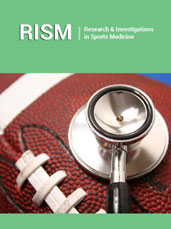- Submissions

Abstract
Research & Investigations in Sports Medicine
Average Sodium Intake Among Student-Athletes at an NCAA Division II University
-
Open or CloseSA Cage1*, AP Jacobsen2, J Gibson3, D Lege1 and Trail LE4
1The University of Texas at Tyler, USA
2The University of Texas Health Science Center at Tyler; UT Health East Texas, USA
3UT Health East Texas, USA
4The University of Texas at Tyler; UT Health East Texas, USA
*Corresponding author:SA Cage, The University of Texas at Tyler, USA
Submission: October 21, 2024;Published: October 29, 2024

ISSN: 2577-1914 Volume10 Issue5
Abstract
Previous research has shown that individuals experiencing dehydration present with decreased cognitive and physical function when attempting to take part in physical activity. Electrolyte balances, particularly those involving sodium and potassium, can also lead to several conditions that can prove detrimental to the overall health of athletes. As such, hydration strategies are a primary consideration for sports medicine professionals, coaching staffs and athletic administrators when planning athletic events. The sodium consumption of average United States citizens has been previously established in previous literature. However, there is a paucity of literature related to sodium consumption among competitive athletes. Without this information, it is difficult to make recommendations for sodium intake for athletes attempting to prevent dehydration and electrolyte imbalances. Therefore, the purpose of this study was to describe the sodium intake of collegiate athletes at an NCAA Division II institution. A secondary purpose of this study was to assess the difference in sodium intake between male and female collegiate athletes. Participants were recruited for this study via emailed invitations to complete an electronic survey. A total of 112 student-athletes (age=20±2 years, Male=31, Female=81) from an NCAA Division II institution were enrolled in this study. The survey included questions collecting information about demographics, and 42 multiple choice questions from a validated sodium intake questionnaire. The majority of participants in this study expressed positive impressions of the tested beverage Overall, participants reported daily sodium intake at a rate consistent 95.1% of the American Heart Association (AHA) recommendation for ideal daily sodium intake limit. Male participants reported an average daily sodium intake consistent with 116%, and females reported consuming an average of 86% of the AHA recommended limit. On average, females reported consuming significantly less sodium than males (t(110)=5.146, p<.001). On average, the student-athletes in this study reported sodium consumption that would be considered adequate, or close to adequate, within the framework established by the AHA. Sports medicine professionals, coaching staffs, and athletics administrators should consider the findings of this study when selected hydration options for their athletes.
 a Creative Commons Attribution 4.0 International License. Based on a work at www.crimsonpublishers.com.
Best viewed in
a Creative Commons Attribution 4.0 International License. Based on a work at www.crimsonpublishers.com.
Best viewed in 







.jpg)






























 Editorial Board Registrations
Editorial Board Registrations Submit your Article
Submit your Article Refer a Friend
Refer a Friend Advertise With Us
Advertise With Us
.jpg)






.jpg)














.bmp)
.jpg)
.png)
.jpg)










.jpg)






.png)

.png)



.png)






